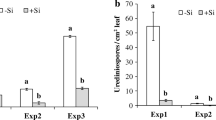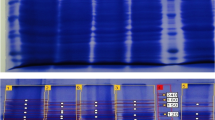Abstract
Beneficial effects of Silicon (Si) on disease control have been shown in a number of plant pathosystems. The present study ascertained the effect of root application of soluble Si on postharvest quality of bitter gourd (Momordica charantia L.) with special reference to the disease development by Fusarium oxysporum. Plants were treated with Potassium silicate (Si+) by amending the soil mix (200 mgSi /kg soil). Treatments were started at the four leaf stage and continued up to 28 days at seven days intervals. Soil amendments with Si significantly reduced the postharvest weight loss and extended the shelf life by 2 days through delayed ripening and reduced fungal rot development. Si analysis in bitter gourds, harvested from Si + plants revealed that fruit tissues accumulated nearly1.5 times as much silicon (0.54% dry weight) as those grown in control (Si-) mix (0.36% dry weight). Extracts from Si + plants exhibited a stronger antifungal activity on thin layer chromatography (TLC) against Cladosporium cladosporioides. Methanolic extracts of fruit pericarp separated on TLC plates showed four antifungal zones at Rf 0.17, 0.51, 0.64 and 0.93. Compound separated at Rf 0.64 was observed in samples from Si + and/or challenged with F.oxysporum. Antifungal zone at Rf 0.51 was present only when Si + fruits were challenged with the fungus. These results suggest that by using soil application of soluble Si, postharvest quality of bitter gourd can be improved and shelf life can be enhanced by 2 days compared to the control. Enhanced fungitoxic activity may have some role in Si-induced disease resistance againstpostharvest fungal pathogens.






Similar content being viewed by others
References
Abeles, F. B., Morgan, P. W., & Saltveit, M. E. (1992). Ethylene in Plant Biology (Vol. 15, 2nd ed.). San Diego, California: Academic Press.
Adikaram, N.K.B. & RatnayakeBandara, B.M. (1998). Methodology for studying defense mechanisms against fungal pathogens: An overview. In: Johnson GI, Highley E, Joyce DC (Eds), Disease resistance in fruit, ACIAR Proceedings No 80 (Xiii) Queensland, Australia, pp177–185.
Anbarasan, A., & Tamilmani, C. (2013). Effect of calcium pectate on the biochemical and pigment changes during the ripening of bitter gourd fruit (Momordica charantiaL. Var-co-1). Asian Journal of Plant Science and Research, 3(4), 51–58.
Anon (1990). Bitter gourd- crop Recommandations. Techno guide. Department of Agriculture Sri Lanka 69–73.
Ariyawansa, J.K. & Abayasekara, C.L. (2005). Postharvest fungal infections in bitter gourd (Momordica charantia) and host defense responses. Proceedings of the Annual Research sessions, University of Peradeniya, 7. Nov. 2005. p96.
Bertling, I., Tesfay, S. Z., Bower, J. P., & Kaluwa, K. (2009). Effect of post-harvest application of silicon on ‘Hass’ avocado fruit. South African Avocado Growers Association, 32, 53–56.
Buck, G. B., Korndorfer, G. H., & Datnoff, L. E. (2010). Extractors for estimating plant available silicon from potential silicon fertilizer sources. Journal of Plant Nutrition, 34(2), 272–282.
Cai, K., Gao, D., Chen, J., & Luo, S. (2009). Probing the mechanism of silicon mediated pathogen resistance. Plant Signaling &Behavior, 4(1), 1–3.
Datnoff, L. E., Rodrigues, F., & Seebold, K. (2007). Silicon and plant disease. In L. E. Datnoff, W. H. Elmer, & D. Huber (Eds.), Mineral Nutrition and Plant Disease (pp. 233–246). St. Paul, MN: American Phytopathological Society.
Dharmakeerthi, R.S., Indraratne, S.P., Kumaragamage, D. (2007). Manual of soil sampling and analysis. Special publication no.10, Soil Science Society of Sri Lanka. Pp 45–46.
Domingo, J. L., Gomez, M., & Colomina, M. T. (2011). Oral silicon supplementation: An effective therapy preventing oral aluminum absorption and retention in mammals. Nutrition Reviews, 69, 41–51.
Elliot, C. L., & Snyder, G. (1991). Autoclave-induced digestion for the colorimetric determination of silicon in rice straw. Journal of Agricultural and Food Chemistry, 39, 1118–1119.
Epstein, E. (1994). The anomaly of silicon in plant biology. Proceedings of the National Academy of Science USA, 91, 11–17.
Epstein, E. (2009). Silicon: Its manifold roles in plants. Annals of Applied Biology, 155, 155–160.
Farooq, M. A., & Dietz, K. J. (2015). Silicon as versatile player in plant and human biology: Overlooked and poorly understood. Frontiers in Plant Science, 6, 994.
Fawe, A, Menzies, J.G., Cherif, M. & Bélanger, R.R. (2001). Silicon and disease resistance in dicotyledons. In Datnoff L.E., Snyder G.H., Korndorfer, G.H. (Ed) Silicon in Agriculture. Elsevier Science, B.V. 159–169.
Fonseka, H. H., Chandrasekera, A., Fonseka, R. M., & Wickremasinghe, P. (2007). Determination of anti-amylase and anti-glucosidase activity of different genotypes of bitter gourd (Momordica charantia) and Thumbakarawila (Momordica dioica). Acta Horticulturae, 752, 131–136.
Grover, J. K., & Yadev, S. P. (2004). Pharmacological actions and potential uses of Momordica charantia. A review. Journal of Ethno pharmacology, 93, 123–132.
Heine, G., Tikum, G., & Horsi, W. J. (2005). Silicon nutrition of tomato and bitter gourd with special emphasis on silicon distribution in root fractions. Journal of Plant Nutrition and Soil Science, 168, 600–606.
Heine, G., Tikum, G., & Horsi, W. J. (2007). The effect of silicon on the infection by and spread of Pythium aphanidermatum in single roots of tomato and bitter gourd. Journal of Experimental Botany, 58(3), 569–577.
Jones, L. H. P., & Handreck, K. A. (1967). Silica in soils, plants and animals. Advances in Agronomy, 19, 107–149.
Kaluwa, K., Bertling, I., Bower, J.P., Tesfay, S.Z. (2010). Silicon application effects on Hass avocado fruit physiology. South African Avocado Growers Association 33: Pp44–47.
Lewin, J., & Reimann, B. E. F. (1969). Silicon and plant growth. Annual Review of Plant Physiology, 20, 289–304.
Liu, J., Chen, J., Wang, C., & Qui, M. (2009). New cucurbitane triterpenoids and steroidal glycoside from Momordica charantia. Molecules, 14, 4804–4813.
Mditshwa, A., Bower, J. P., Bertling, I., Mathaba, N., & Tesfay, S. Z. (2013). The potential of postharvest silicon dips to regulate phenolics in citrus peel as a method to mitigate chilling injury in lemons. African Journal of Biotechnology, 12, 1482–1489.
Menzies, J.G., Ehret, D,L,, Glass, A.D.M., Helmer, T., Koch, C., Seywerd, F. (1991). Effects of soluble silicon on the parasitic fitness of Sphaerotheca fuliginea on Cucumis sativus. Phytopathology 81:84–88.
Nielsen, F. H. (2014). Update on the possible nutritional importance of silicon. Journal of Trace Elements in Medicine and Biology, 28, 379–382.
Nigro, F., Schena, L., Ligorio, A., Pentimone, I., Ippolito, A., & Salerno, M. G. (2006). Control of table grape storage rots by pre-harvest application of salts. Postharvest Biology and Technology, 42, 142–149.
Ratnayake, R. M. R. N. K., Sumithra, H. J., Fernando, M. D., & Palipane, K. B. (2009). Effect of GRAS compounds on aspergillus rot of woodapple (Ferronia acidissima). Phytoparasitica, 37, 431–436.
Ratnayake, R.M.R.N.K., Daundasekera, W.A.M., Ariyarathne, H.M., Ganehenege, M.Y.U. (2014). Effect of silicon application on fungal diseases in bitter gourd (Momordicacharantia L.) leaves. Proceedings of PGIS research congress. University of Peradeniya, Sri Lanka p74.
Ratnayake, R. M. R. N. K., Daundasekera, W. A. M., Ariyarathne, H. M., & Ganehenege, M. Y. U. (2016). Some biochemical defense responses enhanced by soluble silicon in bitter gourd-powdery mildew pathosystem. Australasian Plant Pathology, 45(4), 425–433.
Raven, J. A. (2001). Silicon transport at the cell and tissue level. In L. E. Datnoff, G. H. Snyder, & G. H. Korndorfer (Eds.), Silicon in agriculture. Studies in plant science, 8 (pp. 41–55). Amsterdam: Elsevier.
Rodrigues, F. A., Vale, F. X. R., Datnoff, L. E., Prabhu, A. S., & Korndörfer, G. H. (2003). Effect of rice growth stages and silicon on sheath blight development. Phytopathology, 93, 256–261.
Sakr, N. (2016). The role of silicon (Si) in increasing plant resistance against fungal diseases. Hellenic Plant Protection Journal, 9, 1–15.
Saltveit, M. E. (1999). Effect of ethylene on quality of fresh fruits and vegetables. Postharvest Biology and Technology, 15, 279–292.
Shetty, R. B., Jensen, B., Shetty, N. P., Hansen, M., Hansen, C. W., Starkey, K. R., & Jorgensen, H. J. L. (2012). Silicon induced resistance against powdery mildew of roses caused by Podosphaera pannosa. Plant Pathology, 61, 120–131.
Snyder, G. H. (2001). Methods for silicon analysis in plants, soils, and fertilizers. Studies in Plant Science, 8, 185–196.
Tarabih, M. E., El-Eryan, E. E., & El-Metwally, M. A. (2014). Physiological and pathological impacts of potassium silicate on storability of Anna apple fruits. American Journal of Plant Physiology, 9(2), 52–67.
Van Bockhaven, J., Spichal, L., Novak, O., Strnad, M., Asano, T., Kikushi, S., Hofte, M., & Vleesschauwer, D. D. (2013). Silicon induces resistance to the brown spot fungus Cochliobolus miyabeanus by preventing the pathogen from hijacking the rice ethylene pathway. New Phytologist, 206, 761–773.
Weisheng, L., Yue-wern, H., Xiao-Dong, Z., & Ma, Y. (2006). In vitro toxicity of silica nanoparticles in human lung cancer cells. Toxicology and Applied Pharmacology, 217, 252–259.
Zong, R., Morris, L., & Cantwell, M. (1995). Postharvest physiology and quality of bitter melon (Momordica charantia L.). Postharvest Biology and Technology, 6, 65–72.
Acknowledgements
Financial assistance by the National Research Council of Sri Lanka under the Grant Number NRC 11/118 is highly appreciated.
Funding
This research project was funded by National Research Council of Sri Lanka Under the grant Number NRC/11/118.
Author information
Authors and Affiliations
Corresponding author
Ethics declarations
Conflict of interest
The authors declare that they have no conflict of interest.
Rights and permissions
About this article
Cite this article
Ratnayake, R.N.K., Malkanthi Daundasekera, W.A., Ariyarathne, H.M. et al. Pre-harvest root application of soluble silicon improves postharvest quality and induces antifungal compounds in bitter gourd (Momordica charantia L.). Phytoparasitica 46, 541–549 (2018). https://doi.org/10.1007/s12600-018-0680-8
Received:
Accepted:
Published:
Issue Date:
DOI: https://doi.org/10.1007/s12600-018-0680-8




